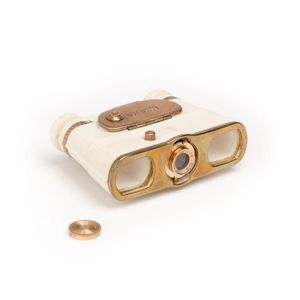Japanese Bronze Pen Receptacle with Carved Netsuke
You must be a subscriber, and be logged in to view price and dealer details.
Subscribe Now to view actual auction price for this item
When you subscribe, you have the option of setting the currency in which to display prices to $Au, $US, $NZ or Stg.
- Boxwood - Boxwood is a hard, yellow coloured, close grained timber. In the 19th century it was often used for inlays, especially stringing, because of its contrasting colour to the darker timbers of the carcase. Stringing is the inlay of a narrow strip of veneer of a lighter colour, such as boxwood along or close to the edges of an object that has been veneered in a darker timber such as mahogany.
Because of its fine grain and resistnce to splitting or chipping it has also been used for treen, turnings, carvings and other small wooden items, such as chess pieces. - Ojime - An ojime is a small decorative bead that is used as a sliding bead or toggle on the cord of a traditional Japanese netsuke. The netsuke is a small sculptural object that was used to fasten a container, such as a box or pouch, to the obi (sash) worn with a traditional Japanese kimono.
The ojime was used to adjust the length of the cord or to secure the container in place. Ojime beads were typically made from a variety of materials such as wood, ivory, bone, and stone. They were often elaborately carved with intricate designs or decorated with colourful lacquer, enamel, or inlay work. - Patination / Patina - In broad terms, patination refers to the exterior surface appearance of the timber, the effect of fading caused by exposure to sunlight and air over the course of a century or more, changing the piece to a soft, mellow colour.
As patina is very difficult to replicate, it is one of the most important guides to determining the age of furniture.
Patina is also the term applied to the bloom or film found on old bronzes due to oxidisation. - Bronze - An alloy of copper and tin, traditionally in the proportions of about 9 parts of copper to 1 part of tin.
The discovery of bronze in Western Asia in the 4th century enabled people to create metal objects which were superior to those previoulsy possible because of its strength and hardness, and it has been used throughout the world for weapons, coins, tools, statuary and other decorative items.
It is very fluid in a molten state, and its hardness, strength when set, and non-corrosive properties makes it most suitable for casting sculpture.
This item has been included into following indexes:
Visually similar items

Victorian gold and diamond M bar brooch, length 4.5 cm 3.5grams, total

A crocodile skin belt, L. 144 cm

An early Australian 9ct yellow gold shield bar brooch, one round red paste gemstone, attributed to Aronson & Co., Wt 3.3grams

Binoca (Japan): Binoca Picture Binocular, c1950, 16 mm sub-miniature camera (with cassette present) built into opera glasses [#73010]. Bicon f4.5 40 mm lens (with cap) and brackets for neck cord.
